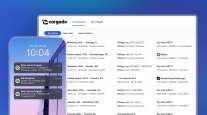Opinion: Taking Aim at Deadhead Miles With Technology
A recent survey of heavy-haul truckers determined the three factors that would have the biggest impact on their business were receiving a higher rate per mile, getting paid faster and spending less time finding their next load.
If technology could help carriers source loads smarter, maximize their driving hours and ultimately put more cash in their pockets, that would be a good thing, right? Well, there are technologies available today that can give carriers access to more opportunities, fill in gaps with loads that they might not have previously found and make it easy to match loads from a drop-off location.

Kropp
It’s time to move into the next generation of tech-enabled dispatching and load matching. We can use technology to transform the current trucking ecosystem by significantly decreasing the amount of empty trucks on the road — the dreaded deadhead miles. And nothing is more frustrating or detrimental to profits than driving long deadheads for a new load or accepting undesirable rates on backhauls.
The most likely impact advances in technology will have is going to be in driver aids that make the job safer and more efficient. With the adoption of these types of innovations, we will see a more level playing field where everyone can take advantage. Among these innovations, freight marketplaces are one that can be a game changer, especially for smaller fleets.
Freight marketplace software can make routing more efficient, make the transfer point from one job to another quicker and reduce deadhead miles — all helping to make drivers more productive and earn more income. Increased efficiency will equal larger margins, which can help carriers offer drivers higher rates.
But for this type of tech-enabled load sourcing to work, data is needed from carriers — information such as upcoming drop-offs and regular availabilities. That’s where electronic logging devices and connected technology come in, as the technology behind ELDs can serve as a gateway to other technical innovations, such as freight marketplaces. Having greater visibility into the location of every truck on the road and matching that capacity to demand can keep trucks loaded and give drivers more paying miles.
This is especially important for the next generation of drivers. According to the 2018 Heavy Haul Survey, younger truckers (under 45 years old) book loads via online marketplaces 48% more often than their older counterparts; little surprise, as it is second nature for younger drivers to utilize technology to address their needs. But with these tools, they’re able to find new loads quicker and run more efficiently, boosting profitability. Of note, that same survey found that the average driver spends more than four hours per day searching for loads.
Marketplaces with shipper direct loads can make quick and easy work of finding and matching available loads, with the freight rate all-inclusive. Plus, marketplaces provide benefits, such as getting paid instantly upon drop-off, acquiring permits online and allowing software to manage cumbersome documentation.
For sure, we are in a time of rapid technological change that can make the job of driving a truck easier, more lucrative and, ultimately, a more exciting prospect for people entering the workforce.
But not every new development is primed to make an immediate impact. There’s still plenty standing in the way of fully autonomous vehicles on public roads, but even partial autonomy in freight hauling could be favorable for drivers. Take platooning technology, which allows two or more trucks to follow one another closely to reduce air drag and fuel consumption. This technology already saves fuel cost and cuts emissions. With regulation of this technology likely to evolve, it is easy to imagine the driver in the rear truck taking their mandatory rest period while the computer follows the lead truck, which will have a driver at the wheel.
Also, let’s remember that there are many areas in trucking where drivers will be needed for a long time to come. Take oversize freight, for example. Given the risk and complexity of these loads, it seems unlikely that they can be fulfilled without human involvement.
While what happens in the decades beyond is anyone’s guess, current technology will undoubtedly benefit fleets and drivers as the implementation thus far has been to assist rather than replace.
Kropp is the co-founder and CEO of FR8Star.com, a digital marketplace for flatbed and oversize truck freight. Founded in 2015, FR8Star develops cloud-based, data-driven tools designed to help improve efficiencies and reduce costs in the open deck freight industry.


